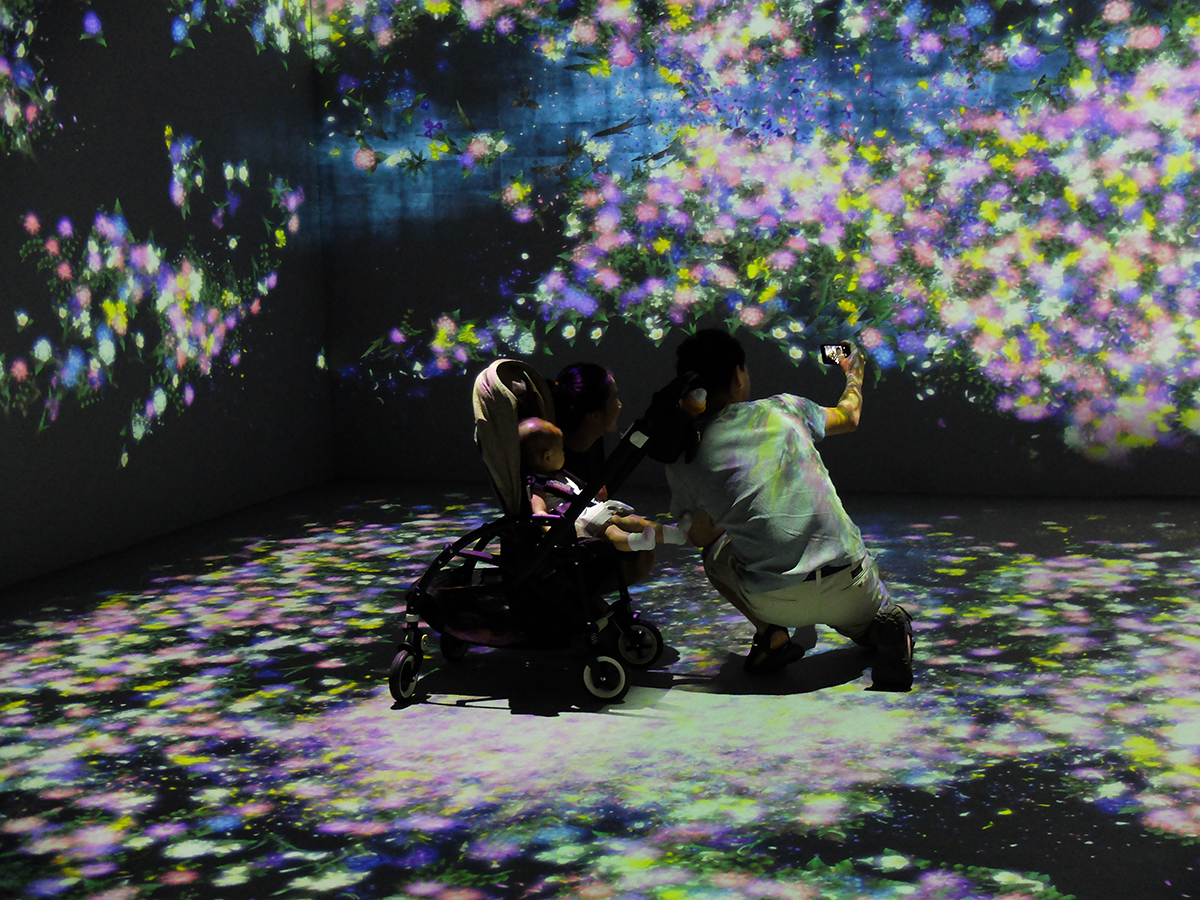Flowers & People
A young family enjoys the digital installation 'Flowers and People cannot be controlled but Live Together' by teamLab, a group of Japanese artists.
A young family enjoys the immersive digital installation 'Flowers and People cannot be controlled but Live Together.' It was part of the 'Art in Motion' series during Singapore art week. I noticed more than 8 massive projectors used to create the space. The flowers and petals grow, wither and die. As you move, the petals try to grow around you along with a tinkling almost fairy-like sound. Overall a beautiful, almost meditative experience.
Ramkinkar Baij
However it was enlightening to see his growth as a brilliant artist and the extent to which his personal philosophies, politics and ideas were so deeply and honestly entrenched in his work and life. Baij clearly 'lived' his ideals, spending a lot of time with the Santhals who were a prominent topic within his work.
I recently visited NGMA, where they had an exhaustive collection of this artist's work. At first I was skeptical about what was clearly a collection of work from a long ago era of Indian art. Personally, I favor viewing more radical or contemporary works. However it was enlightening to see his growth as a brilliant artist and the extent to which his personal philosophies, politics and ideas were so deeply and honestly entrenched in his work and life. Baij clearly 'lived' his ideals, spending a lot of time with the Santhals who were a prominent topic within his work. His abstract sculptures were a pleasure and my favorites amongst his life's work. His sculptures of animals were brilliant and at times even humorous.
Dog by Ramkinkar Baij, Terracotta, 1950's. 38.5 by 29.5 by 22cm. Image Source: Delhi Art Gallery.
The Poet by Ramkinkar Baij. 1938. Image Source.
Other works worth noting are The Harvest 1957 (oil on canvas), Atomika 1969 (oil on canvas), and a sculpture portrait of Pramod Ganguly (Plaster of Paris).
Nico Vascellari
The artist and musician creates sound and light installations that center around themes of nature, spaces, and spiritualism. His work at the Biennale interested me because of his use of shadow, especially the way the audience's shadows are incorporated into projected slides of his collage work. The experience is amplified by a loud sound every time the slide physically changes since an old world projector is used.
Nico Vascellari. Untitled Horizons, 2011. Collage on Paper 120 slides, three slide projectors. Dimensions variable. Courtesy of Bugada & Cargnel, Paris. Photo by Aditi Kulkarni, Venice.
Reference: Bugada and Cargnel. 2011. Nico Vascellari. [online]. Available from: http://www.bugadacargnel.com/en/pages/artistes.php?name=21891. Accessed 21st June 2011.
Dayanita Singh
I am especially interested in her attempts to express her own visions of a place or city, opposing the singular story people usually expect about India, that of 'sensational catastrophes and human failures'
Phil mentioned Singh in connection to my work on Mumbai because of her series of photographs titled Dream Villa. Her landscape images of Mumbai resonate with the kind of video I'm using for my installation. I am especially interested in her attempts to express her own visions of a place or city, opposing the singular story people usually expect about India, that of 'sensational catastrophes and human failures' (Cotter, H. 2005). Dream Villa 11. 2008. Dayanita Singh [Image Source]
House of Love 2010. Dayanita Singh. [Image Source].
Reference: Cotter, H. 2005. Objects of Repose and Remembrance. New York Times. [online]. Available from: http://www.nytimes.com/2005/03/30/arts/design/30cott.html?ex=1172638800&en=840b508f152bce9e&ei=5070 Date Accessed: 21st July 2011.
Degen, N. 2008. Dayanita Singh. Frieze Magazine. [online]. Available from: http://www.frieze.com/shows/review/dayanita_singh/. Accessed: 21st July 2011.
Dayanita Singh: House of Love. La Lettre. [online]. Available from: http://lalettredelaphotographie.com/entries/dayanita-singh-house-of-love. Date Accessed: 7th August 2011.
Shift
Shift the post-graduate show will be held at the Arts University College Bournemouth from 2nd to 9th September, open from 10am to 4:30pm daily. Entry is free. The show will be open for a late night viewing on the 8th (Thursday) and is closed on Sunday.
 Shift the post-graduate show will be held at the Arts University College Bournemouth from 2nd to 9th September, open from 10am to 4:30pm daily. Entry is free. The show will be open for a late night viewing on the 8th (Thursday) and is closed on Sunday. The Facebook page is here.
Shift the post-graduate show will be held at the Arts University College Bournemouth from 2nd to 9th September, open from 10am to 4:30pm daily. Entry is free. The show will be open for a late night viewing on the 8th (Thursday) and is closed on Sunday. The Facebook page is here.
Don't miss it! The exhibition will showcase the work of post-graduate students in Animation, Contemporary Performance, Graphic Design, Interactive Media, Costume, Fashion, Fine Arts and Photography. The work will reflect the multidisciplinary nature of the post-graduate course here at AUCB, and each student's individual pathway.
Stay tuned for more updates on the show. And if you can't make it don't fret, I will be posting photos and videos of the awesome event :)
Update: Photos and videos here.
Crystal of Resistance
'But art is not resistance to something. It is resistance as such. Art is resistant because it resists everything that has already existed and been known. Art, as a resistance, is assertion, movement belief, intensity, art is 'positive.' Art resists tradition, morality and the factual world. Art resists every argumentation, every explanation and every discussion.'
Crystal of Resistance is a work by Thomas Hirschhorn. Below are a few lines from the catalogue where the artist talks about his philosophy on art:
'But art is not resistance to something. It is resistance as such. Art is resistant because it resists everything that has already existed and been known. Art, as a resistance, is assertion, movement belief, intensity, art is 'positive.' Art resists tradition, morality and the factual world. Art resists every argumentation, every explanation and every discussion.'
The artist uses the crystal as a repeating motif, transforming the gallery space into another world. I felt as if I'd been transported into a parallel universe, inexplicable and fascinating. The use of everyday objects such as ear-buds, brown tape, mirrors and mobile phones gives the entire work a surreal and disconcerting mood.
Cracked Culture? Contemporary Chinese Art
Cracked Culture? The Quest for Identity in Contemporary Chinese Art. Curators: Wang Lin (China), Gloria Vallese (Italy). Organizer: Guangdong Museum of Art, China. Photos by Aditi Kulkarni.
Cracked Culture? The Quest for Identity in Contemporary Chinese Art. Curators: Wang Lin (China), Gloria Vallese (Italy). Organizer: Guangdong Museum of Art, China. Photos by Aditi Kulkarni.
 Jiao Xingtao. The Powerful Dragon. 258X38X170cm. Mixed Medium. 2011.
Jiao Xingtao. The Powerful Dragon. 258X38X170cm. Mixed Medium. 2011.
 Shi Jindian. Blue 750. Coloured Fibre in Stainless Steel. 260X170X120cm. 2008.
Shi Jindian. Blue 750. Coloured Fibre in Stainless Steel. 260X170X120cm. 2008.
Gao Yang. Jingzhe. Mixed Medium. 210X85cm. 2010.
Gao Yang. Mixed Medium 2011. Mixed Medium. 150X120cm. 2011.
 Ying Tianqi. Memory Loss. Mixed medium. 122X130cm. 2007.
Ying Tianqi. Memory Loss. Mixed medium. 122X130cm. 2007.
 Resi Girardello/ Vanas-Omnia Vincit Vanitas. Work with spun copper enameled in various colors and sizes, metal structure. 200X180X90cm. 2009.
Resi Girardello/ Vanas-Omnia Vincit Vanitas. Work with spun copper enameled in various colors and sizes, metal structure. 200X180X90cm. 2009.
 Ying Tianqi. Traces of the Vicissitudes. 2011.
Ying Tianqi. Traces of the Vicissitudes. 2011.
Ying Tianqi Resurrects the Life of Yore in the Old City on the Spot: "In China, when the bulldozers were marching like an army across the ancient city of Wuhu where I spent my childhood. I determined to shoot the record of this dramatic change with my video camera. Before the old city was demolished, I set my video camera at a sport shooting a street of neibhourhood and the life of a household from dawn till midnight for 12 hours. The same day a year later, that place had turned to ruins, and I played the video on the spot showing the life of people there a year before, both times of which happened to be the Chinese Dragon Boat Festival."
Future Pass
"Over 100 artists, both Asian and non-, offer a kaleidoscopic panorama of a new aesthetic paradigm currently proliferating from Asia to the rest of the world. Crossing genres and disciplines as they appropriate the digital culture of the 21st century, artists working in this eclectic new aesthetic are generating new types of relationships to the globalizing world."- Excerpt from the Short Guide distributed at the exhibition. Future Pass - From Asia to the World. Collateral Event Biennale Arte 2011. June 4th - Nov. 6th 2011.
 Kaikai Kiki/Chiho Aoshima. 1974-. Little Carefree, The Chicken Girl. FRP, Lacquer. 33X20X53 cm. 2008.
Kaikai Kiki/Chiho Aoshima. 1974-. Little Carefree, The Chicken Girl. FRP, Lacquer. 33X20X53 cm. 2008.
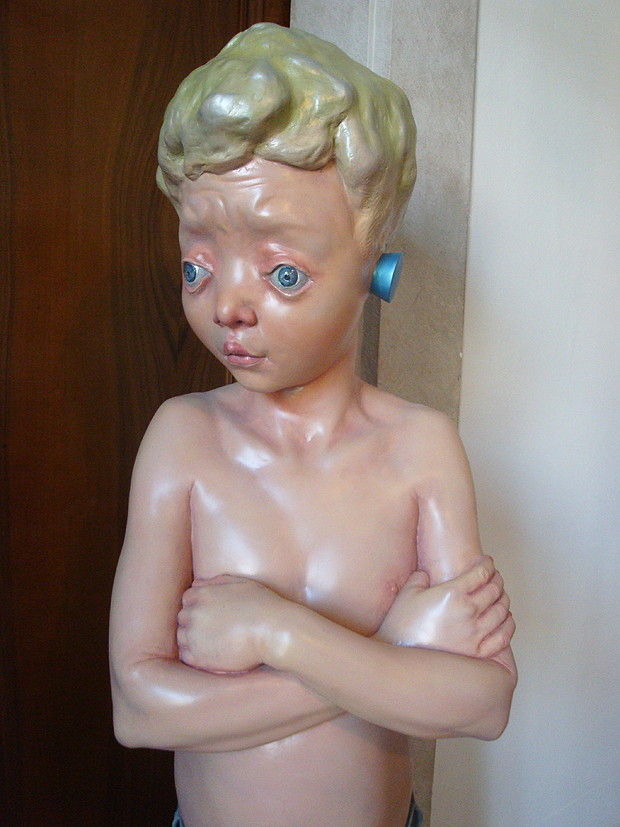 Yan Shi Lin. 1982-. What's the Matter. FiberGlass Paint. 2010.
Yan Shi Lin. 1982-. What's the Matter. FiberGlass Paint. 2010.
The word 'kaleidoscope' is an accurate description of this brilliant collection of work by a wide range of artists from across asia and the world. I spent hours here and didn't regret it for a moment (we had only 5 days to see the entire Biennale). If anyone asked me what the best thing to see in the Biennale was, it would be Future Pass. Several of the artists were also around when we visited, which made it an unforgettable experience.
 Andre Saraiva. 1971-. Mickey Wiagra. Polyester Resin, Strattee a structure - skeleton frame. 198X140X125 cm.
Andre Saraiva. 1971-. Mickey Wiagra. Polyester Resin, Strattee a structure - skeleton frame. 198X140X125 cm.
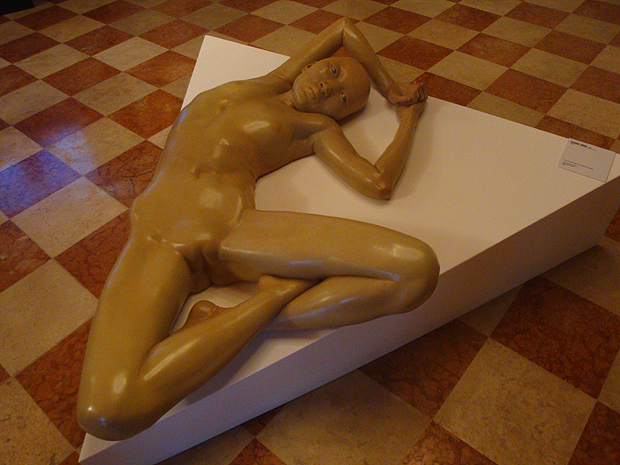 Xiang Jing. 1962-. I am 22 years old, but without my period. Fibre glass painted. 30X155X95 cm.
Xiang Jing. 1962-. I am 22 years old, but without my period. Fibre glass painted. 30X155X95 cm.
 Ward Walrath Kimball. 1914-2002. Untitled. Drawings on found posters. Sizes varied. Made in the 1960's.
Ward Walrath Kimball. 1914-2002. Untitled. Drawings on found posters. Sizes varied. Made in the 1960's.
 Victor Xu Weina. 1981-. (animamix.net). Magician. Fiberglass paint. 50X22X22 cm X3. 2009.
Victor Xu Weina. 1981-. (animamix.net). Magician. Fiberglass paint. 50X22X22 cm X3. 2009.
Kea. 1980-. A Salute to Fashion. Acrylic on Canvas. 162X130cm. 2011.
Wang Mai. 1972-. Using wisdom to capture the oil monster #12. Mixed material. 160X100X200 cm. 2011. [detail].
 Qu Yi. 1985-. Kiss Me Hard. Series of photographs.
Qu Yi. 1985-. Kiss Me Hard. Series of photographs.
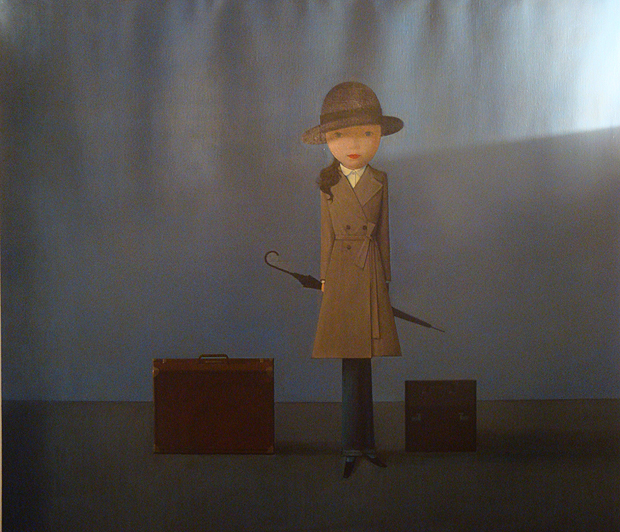 Liu Ye. Miss, 2008. Acrylic on Canvas. 140X160 cm. Private Collection.
Liu Ye. Miss, 2008. Acrylic on Canvas. 140X160 cm. Private Collection.
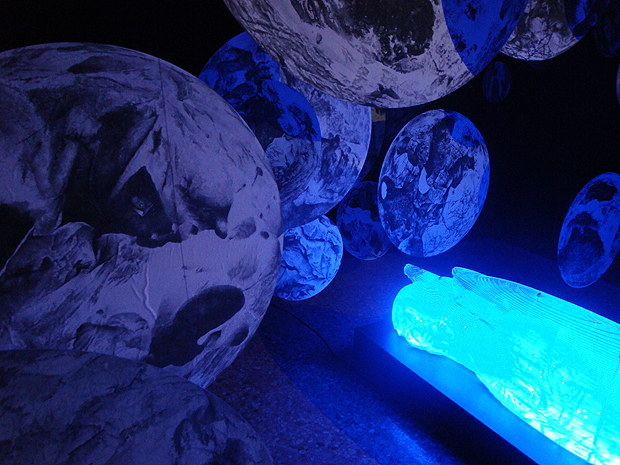 Li Hui. 1977-. Motor-Inherent Danger. Acrylics, LED Lamp, Stainless steel. 240X50X50cm. 2008.
Li Hui. 1977-. Motor-Inherent Danger. Acrylics, LED Lamp, Stainless steel. 240X50X50cm. 2008.
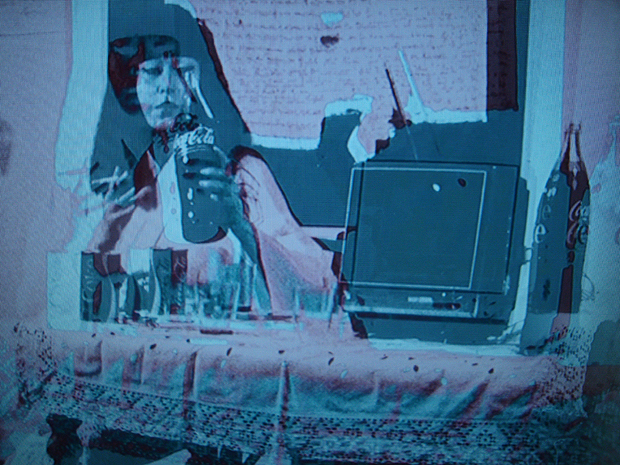 Yoko Toda. 1944-. Unknown Ideal. Video. 2009, 2011.
Yoko Toda. 1944-. Unknown Ideal. Video. 2009, 2011.
 David Chan. 1979-. Feeding the Stupid Monkey. Oil on Linen. 150X180 cm.2010.
David Chan. 1979-. Feeding the Stupid Monkey. Oil on Linen. 150X180 cm.2010.
 Cao Fei. 1978-. RMB City. Since 2009. Internet Project. RMB City is developed by Cao Fei & Vitamic Creative space. Facilitator: Uli Sigg. Courtesy of Artist and Sigg Collection.
Cao Fei. 1978-. RMB City. Since 2009. Internet Project. RMB City is developed by Cao Fei & Vitamic Creative space. Facilitator: Uli Sigg. Courtesy of Artist and Sigg Collection.
 Grimanesa Amoros. Uros Island. 414X340X66cm.
Grimanesa Amoros. Uros Island. 414X340X66cm.
Untitled Installation by Mu Lei. Video projection on a bathtub.
[Future Pass - From Asia to the World. Collateral Event Biennale Arte 2011. June 4th - Nov. 6th 2011. The UNEEC Culture and Education Foundation Taipei, The Today Art Museum of Beijing, The Wereldmuseum of Rotterdam, The National Taiwan Museum of Fine Arts, In Collaboration with the Fondazione Claudio Buziol of Venice, curated by Victoria Lu, Renzo di Renzo and Felix Schober].
Laundry Room City
![]() Participants: Michael Moore, Samantha Else, Baran Saragul, Rina Miyake, Ben O'Shea, Taro Morimoto, Yi Lu, Tanya and me.
Photos by Samantha Else and me. Paper-mache dolls and houses by Yi Lu. Video and installation set-up by Aditi Kulkarni.
Participants: Michael Moore, Samantha Else, Baran Saragul, Rina Miyake, Ben O'Shea, Taro Morimoto, Yi Lu, Tanya and me.
Photos by Samantha Else and me. Paper-mache dolls and houses by Yi Lu. Video and installation set-up by Aditi Kulkarni.
Since I live in a building full of artists, I decided to invite everyone to one of my spontaneous experiments with the Mumbai videos. Using objects I found in the laundry room such as pieces of thermocol, cardboard boxes, chairs, clothespins and piles of yellow pages I created a crowded, urban space. No sound was used since I couldn't find speakers. After the first thirty minutes of discussion and feedback, people started adding and subtracting to the work, literally "playing" with the objects I had collected and even adding their own. Overall it was exciting since I felt it was relevant to the process of literally "building" a city which is unplanned and crowded like Mumbai, filled with so many different people. Eventually Yi Lu added her own work to the installation; fantasy objects such as houses and dolls made of paper-mache.
This event lead to the collaborative work Tobari no Akari by Taro Morimoto, Yi Lu and me. It also formed the base for my later experimentation with City Memories. Sam and Michael came up with the suggestion to use lego, which lead to Lego city #1.
Installations & Inspiration
Gerry Judah Paintings.
Fire with Fire (2010) by Isabelle Hayeur 3 channels video installation. Video projection of 15 minutes playing in continuous loop. 3 Blu-ray players, 3 video projectors. 112 West Hastings Street, Vancouver. Fire with Fire has been commissioned by The Vancouver 2010 Cultural Olympiad. Curator : Marlene Madison.
Rosa Barbara at Tate Modern. Article about the work here.
Show Homes and Display Desire (2007) by Vesna Pavlović. "Within the “Display, Desire” installation, the prints simultaneously function as images of display and display of images. Strange details of the American home are exposed, through the language of cinema and mechanisms of projection. The projection of black and white transparencies onto semi-transparent Plexiglas screens suggest the plastic quality of the interiors, and within the overlapping projection spaces, the images transform, exploring possible representations of the photographic medium itself."
Art Direction & Visuals: Deniz Kader – Candaş Şişman, Music & Sound Design: Görkem Şen, Project Management: Erdem Dilbaz, Modelling: Gökhan Uzun – Can Dinlenmiş (prospektif.org)
JR's (French Street Artist) TED Prize Wish: Use Art to turn the world Inside Out.
Dark Stuff
I stumbled on the work Dark Stuff (2008) while looking at random postcards being sold at the British Museum in London. Tim Noble and Sue Webster had created an impressive image inspired by Egyptian mummies, and it motivated me to look for more of their work. Then I found Sunset in Manhattan (2003).
Dark Stuff, 2008 by Tim Noble and Sue Webster 189 mummified animals (67 field mice, 5 adult rats, 42 juvenile rats, 44 garden shrews, 1 fox, 1 squirrel, 1 weasel, 13 carrion crows, 7 jackdaws, 1 blackbird, 1 sparrow, 1 robin, 1 toad, 1 gecko, 3 garden snail shells), glue, metal stands, light projector [Visit Image Source]
Sunset over Manhattan, 2003 Cigarette packets, tin cans shot by air gun pellets, wooden bench, light projector 110 x 31 x 75 cm (431/3 x 121/4 x 291/2 in) [Visit Image Source]
Here the use of rubbish combined with light and shadow creates a city that is recognizable as Manhattan, and at the same time makes an important comment about the place itself. At this point in my project I explored the use of objects in my installations and what kind of objects would be relevant to the concept of the fantastical and the real.
Group Critique
Overall Feedback:Brian Catling (performance artist and poet) mentioned that I could add a layer of virtual shadows to the video installation, in addition to the real shadows thrown by the audience. He also mentioned that since the user's action is central to viewing the work, it's almost as if the user is causing the resulting violence/action, in this case the image of a burning building that becomes visible only in the user's shadow. In answer to my question about the kind of space I should use for the installation, he said that using a clean, "constructed" white room would work best with the concept. There was a brief discussion on the lack of sound used, and he thought that sound was not required at all.
Several artists and films that could help develop my practice were mentioned: such at Kit Wise, Rope by Hitchcock and "London" and "Robinson in Space" by Patrick Keiller. I was also directed to Foucault's theories of Heterotopia, Dystopia and Utopia; "Non Places - Introduction and an Anthropology of Super Modernity" by Mare Ange and the History of the Shadow by V. Strichita.
Reflection: The use or lack of sound is an important issue which I still have to properly integrate into the concept of the bipolar, constructed realities. However I agree with Brian in that the sound itself is not very important to the installation. It is a concern to me that the sound or music could dominate the visuals. The result should be dream-like, since dreams have a tendency to have faded or muted sounds when remembered. Examples of appropriate sounds are: muted voices, very low volume music, or something subtle such as crackling of fire and gunshots in the distance. During the presentation I also realized that a subtle difference between the "here" and the "elsewhere" is better than an overly dramatic and "literal" difference. The space itself is still an issue which I need to work on to some extent. A large part of phase 2 will be building on the space, experimenting with the use of objects along with projectors, and trying the 360 degree panorama. Overall, creating the presentation helped me organize my thoughts in terms of the kind of framework and process I followed, looking at the gaps in my reasoning and further steps I needed to take in my research.
Notes: Topics to read further: Para-Feminism, Invisible artwork, Family photographs as imposed memories, Leonard Talmy: Force Dynamic in language: "door is closed" vs the "door cannot be opened." Uses of Enchantment by Bruno: interesting book about fairy tales, Costume vs. Fashion is the folk (narrative, story) vs. elite (market, consumer); Physiology of taste by Brillat Savarin; Dutch golden age (objects with meaning, symbols) - using a room or a window to project against or using meaningful objects in the installation; Shadows: Using shadows in different tones, different light sources. Also interesting is the book Praise the Shadow; Constructed Reality: creating from photographs, memory, or not even that, but just found photographs is one step down. Films: Many Moons (2008) b Janelle Monae; Coraline (animation); Eraserhead by David Lynch
Circle of Confusion
One line from this article grabbed me: "It is impossible to grasp the city, one can only take a fragment of it."
 [Image Source] | Circle of Confusion by Joana Hadjithomas and Khalil Joreige | Photographic installation | Mirror, colour digital prints (3,000 pieces), ink inscriptions.
[Image Source] | Circle of Confusion by Joana Hadjithomas and Khalil Joreige | Photographic installation | Mirror, colour digital prints (3,000 pieces), ink inscriptions.
The work resonates with the aim of my project, as it seeks to represent the city of Beirut: how it's various and poorly documented conflicts have cut it into pieces, making it impossible to make a "true" picture of it, inviting the user to destroy the city by taking pieces off the board and scattering them, revealing a layer beneath. One of the questions brought up in the article is: "How does the viewer’s participation in this work, by removing and taking possession of a fragment of the city of Beirut, add to the meaning of Circle of Confusion?"
Similarly I can attempt to create a question for my work: How does the viewer's participation in this work, by revealing the hidden city of Mumbai in the viewer's shadows, add to the meaning of Mumbai+Bombay?
Peer Critique
We organized a peer critique for the 14th of December to discuss our work. At this point most people are midway through their projects. About 12-15 part-time and full-time MA students attended the workshop. I presented a video and photographs from a recent installation test. Here are some points of reaction to my work: > Simple, yet effective
> Interactive without the use of very complex technology. Since the user is essential to viewing the artwork.
> Use of technology is secondary to the concept.
> Prefer to see it projected on walls, instead of floor since it's more natural.
> Want to see more animation: people, events, day changing to night.
> Want to see a more dramatic difference between the two skylines.
> One person interpreted the "real" city as a doomsday city since it contains images of poverty and burning buildings.
> Important to note how most people who view the work generalize it to any city rather that Mumbai, unless specifically told.
> Prefer the rough sketchy version of the city.
> Almost a film.
Overall, I realized how different each person's work and philosophy was, from Fine Art to Animation finding common ground is not easy since its like each person is from different planets. At the same time it was useful to see how a fine artist or animator would react to my work. Additionally, various topics such as self-reflexive films, and the "axiomatic" were discussed. I also discovered a piece of work which later became vital to my understanding of my practice. It is called Circle of Confusion by Joana Hadjithomas and Khalil Joreige, 1997. See my notes on this work here.
Abigail Reynolds
Abigail Reynolds: Layering and tessellation.

"The Universal Now: Relief sculptures using found photographs of the same place taken at different times." | Seventeen Gallery.
Reflection: Contemplating possibilities of adding layers to the already existing two layers of light as projections. It is possible that a third city panorama could exist behind the two already conceived, though it would be a print or a painting. It could also be a texture to add another layer of interactivity, that of touch.

